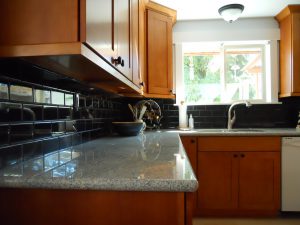
When consulting with clients about their kitchen renovation among the top reasons they give for wanting (and more so, needing) to renovate their kitchen is to get more storage space. Typically this reason is obvious before the client declares their feelings to us about their disdain for their kitchen. All one needs to do is look around a kitchen that is overflowing with utensils, pot, pans, cleaning supplies, dog food, or even garbage to conclude that storage is a problem that we will set out to fix.
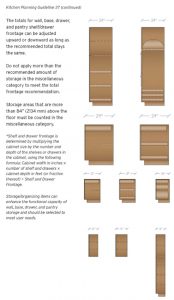 There are many reasons why kitchens get overcrowded and it is typically not due to a hoarding tendency or uncleanliness. In older homes for example, kitchens were not designed to have cabinet space for all of the modern appliances we now enjoy. Cabinets were built on site with large dimension lumber that takes up valuable space. Even if the cabinet technically had the space you might find yourself on all fours trying to dig out the turkey pan from a corner cabinet that was only accessible from a door in an adjacent cabinet. Today’s cabinets can be ordered to very exact specifications which allows a designer to maximize the drawer and shelf space of each unit. Much of the hardware that is available on even stock cabinets was not around 30 years ago. The specialty hardware is so convenient and enticing that most customers opt for these add-ons without hesitation.
There are many reasons why kitchens get overcrowded and it is typically not due to a hoarding tendency or uncleanliness. In older homes for example, kitchens were not designed to have cabinet space for all of the modern appliances we now enjoy. Cabinets were built on site with large dimension lumber that takes up valuable space. Even if the cabinet technically had the space you might find yourself on all fours trying to dig out the turkey pan from a corner cabinet that was only accessible from a door in an adjacent cabinet. Today’s cabinets can be ordered to very exact specifications which allows a designer to maximize the drawer and shelf space of each unit. Much of the hardware that is available on even stock cabinets was not around 30 years ago. The specialty hardware is so convenient and enticing that most customers opt for these add-ons without hesitation.
In earlier posts I introduced some of the new cabinets storage conveniences such as the mixer shelf and dedicated storage drawers. In this article we’ll take a closer look at the specific cabinet storage equations that you can bring with you to the cabinet designer just to ensure that your new kitchen will accommodate all of your pans, appliances, etc.. In Guideline 27 you will see the term “shelf/drawer frontage” which is a way designers estimate the storage space of your cabinets. To get shelf/drawer frontage you multiply the cabinet width (x) number of shelves and drawers (x) cabinet depth. With this formula you can see how your current kitchen storage stacks up to the recommended inches for small, medium, and large kitchens.
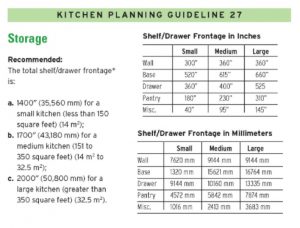 In Guideline 29 you see the illustration of corner cabinets that include a
In Guideline 29 you see the illustration of corner cabinets that include a 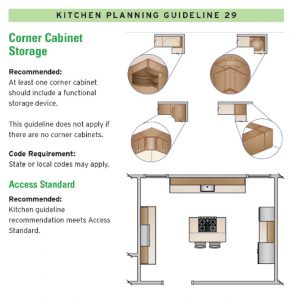 functional option also known as a “Lazy Susan” (sorry Susan). This is a pretty standard feature for today’s corner-base and corner-upper cabinet. One thing to keep in mind is that you can design for a corner cabinet at the end of a straight run (of cabinets) that does not continue on the adjacent perpendicular wall. By adding a corner cabinet in the situation you improve your end cabinet with an increased amount of storage and better access.
functional option also known as a “Lazy Susan” (sorry Susan). This is a pretty standard feature for today’s corner-base and corner-upper cabinet. One thing to keep in mind is that you can design for a corner cabinet at the end of a straight run (of cabinets) that does not continue on the adjacent perpendicular wall. By adding a corner cabinet in the situation you improve your end cabinet with an increased amount of storage and better access.
Lastly, for the items you access most frequently, they should be stored in a cabinet height between 15″-48″ off the floor (see diagram, bottom left). This improved access will help to keep these items organized 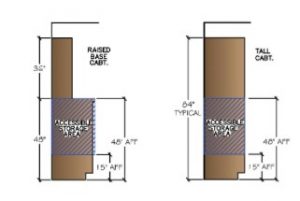 and keep you from overexerting yourself. Giving yourself enough cabinet storage is important but some forethought about where you’ll store what is the detail that you will congratulate yourself on every time you find yourself operating with ease in your new kitchen.
and keep you from overexerting yourself. Giving yourself enough cabinet storage is important but some forethought about where you’ll store what is the detail that you will congratulate yourself on every time you find yourself operating with ease in your new kitchen.
The diagrams are courtesy of National Kitchen & Bath Association
Look for our next post when we’ll introduce: “Whats So Special About an Electrical Receptacle?”
Are you ready to start your Kitchen Renovation?
Contact Us Today to Schedule a Free Consultation
Is there another area of your Home that we can offer you our services?
